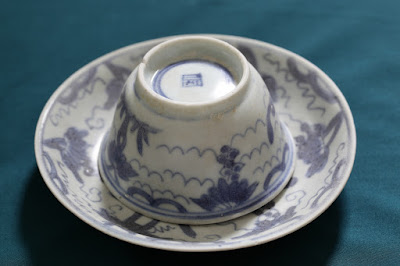Pictures below is a set of blue and white chrysanthemum shipwreck tea bowl and saucer.
This type of blue and white chrysanthemum shipwreck was lost in the South China sea, late 17th Century AD and recovered in 2014.
The early Kangxi Shipwreck And Cargo Analysis of survey, material and cargo samples from the wreck site indicate that the ship was exporting high quality Chinese porcelain made in the 1660s, possibly on behalf of the Dutch East India Company (VOC). The wares were predominantly Jingdezhen blue and white porcelain, although multi-coloured ceramics and utilitarian wares were also uncovered within the cargo. Some items were display wares whilst others were intended for use.
The porcelain recovered from the wreck was exclusively Chinese ceramics, all assessed by experts to be excellent examples of early Chinese Kangxi in origin indicating they were manufactured in the famous porcelain centre of Jingdezhen in the Jiangsu Province.
Jingdezhen kilns made porcelain over two millennia, since the Han Dynasty. They supplied the most artistically advanced ceramics to the world for centuries. Blue and white porcelain was the most famous product of Jingdezhen, and reached the height of its technical excellence in the early Qing Dynasty. The shipwreck pieces recovered are typical of the highest quality blue and white of the Kangxi period, characterized by charming and sophisticated designs. They demonstrate a great expertise in the production of a brilliant under glaze in sapphire blue, applied in five or six tones to produce a vibrant, dimensionally nuanced effect, together with a fine thin attractive white (or slightly bluish) silky glaze applied to a stark white and finely formed body. The cobalt blue colouring is distinctive on the early Kangxi porcelain and is referred to as ‘gem blue’ or ‘kingfisher blue’, which is much purer and brighter than that of Ming Dynasty wares. These shipwreck pieces provide an insight into the quality of the wares that were carried on board the ship to include items such as figurines as well as a delightful variety of vases, plates, bowls, bottles, jars, teapots, cups with saucers and other items. Large pieces were uncommon during this period, their manufacture being made difficult by quality control requirements.
Designs were sometimes based on Buddhist and Taoist themes, or sourced from illustrations of Ming stories such as ‘The Three Kingdoms’ or ‘The Romance of the west Chamber’ together with the dramas ‘Xixiang Ji’ and ‘Wui Hu Zhuan’. Chinese Kangxi blue and white porcelain was increasingly varied and innovative in its designs. The influence of Dutch and other European shapes and designs were in evidence prior to and during the Kangxi period. The very high standards achieved early in Kangxi’s reign, evident in the samples recovered from the shipwreck, mark the high point of quality for Chinese blue and white ceramics. Quality declined in later stages of the Kangxi Emperors reign, as the huge demand for Chinese blue and white porcelain developed in both overseas and home markets, giving rise to a profusion of unregulated kilns. Quality was diluted by increased production volumes, and as the Qing Dynasty progressed, competition from mass produced wares and the instability of the political environment debased the traditional fine porcelain industry.
Saucer : Diameter : 12cm
Bowl : Diameter : 7.5cm, Height : 4cm
 Picture 1
Picture 1
 Picture 2
Picture 2
 Picture 3
Picture 3
 Picture 4
Picture 4
 Picture 5
Picture 5
 Picture 6
Picture 6
